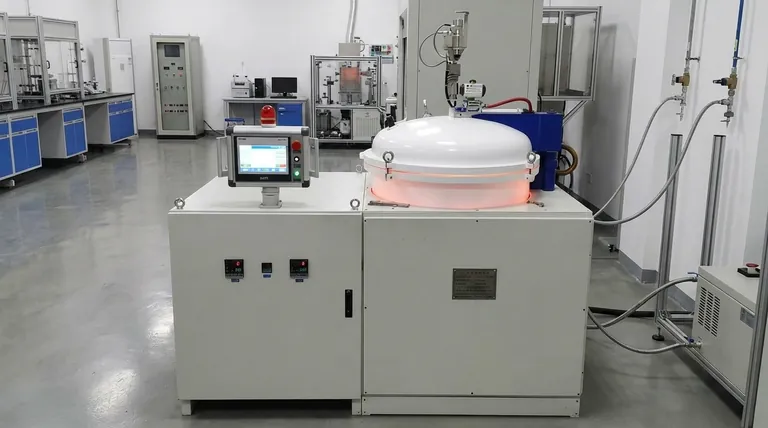In essence, the graphite furnace method is a form of high-temperature electrothermal processing where the furnace's heating elements and chamber are constructed from graphite. An electric current is passed through the graphite, which resists the flow and generates intense, uniform heat. This process is nearly always conducted in a vacuum or a controlled, inert atmosphere to prevent the graphite from oxidizing at extreme temperatures.
The core value of the graphite furnace method lies in its ability to achieve exceptionally high and uniform temperatures very quickly. This makes it an indispensable tool for advanced materials processing where precise thermal control in an oxygen-free environment is critical.

How a Graphite Furnace Works: The Core Principles
The effectiveness of this method stems from the unique properties of graphite and the controlled environment in which it operates. Understanding these principles is key to leveraging its power.
Electrical Resistance Heating
A graphite furnace is a type of resistance furnace. The fundamental principle is simple: electricity is passed through the graphite heating elements.
Due to graphite's natural electrical resistance, this electrical energy is converted directly into thermal energy, generating immense heat inside the furnace chamber.
The Critical Role of Graphite
Graphite is not just a convenient choice; its properties are central to the furnace's performance.
It possesses a low thermal capacity, meaning it heats up and cools down very rapidly. This allows for fast processing cycles.
Critically, a graphite chamber creates near-perfect black body conditions. This ensures that heat is radiated with exceptional uniformity, eliminating hot spots and ensuring the entire workpiece receives the same thermal treatment.
Controlled Atmosphere (Vacuum or Inert Gas)
Graphite furnaces cannot operate in the presence of oxygen at high temperatures. Doing so would cause the graphite components to rapidly oxidize and burn away.
Therefore, the process is always performed within a sealed chamber that is either evacuated to a vacuum or filled with a protective, inert gas like argon. This protects not only the furnace itself but also the material being processed from unwanted chemical reactions.
Key Advantages of the Graphite Furnace Method
The combination of these principles gives the method several distinct advantages over other heating technologies.
Rapid and Uniform Heating
The low density and low thermal mass of graphite allow for exceptionally fast heating and cooling rates. Combined with its black body radiation properties, this results in superior temperature uniformity across the entire heating zone.
High-Temperature Capability
Graphite maintains its structural integrity at extreme temperatures, far exceeding the limits of most metallic heating elements. This makes it ideal for processes that require temperatures well over 2000°C, such as graphitization or sintering of advanced ceramics.
Process Purity and Control
Operating in a vacuum or inert atmosphere creates an ultra-clean environment. This prevents oxidation and contamination of sensitive materials during heat treatment, ensuring high product purity.
Understanding the Trade-offs and Limitations
No technology is without its compromises. Objectivity requires acknowledging the limitations of the graphite furnace method.
Requires a Controlled Atmosphere
The absolute necessity for a vacuum or inert gas environment adds complexity and cost to the system. It is not suitable for applications that must be performed in air.
Potential for Carbon Reactivity
At very high temperatures, carbon can react with certain materials, forming unwanted carbides. This makes it unsuitable for processing specific reactive metals or compounds without careful consideration or protective barriers.
Consumable Components
Graphite heating elements and insulation are consumable. Over time and repeated thermal cycles, they will degrade and require periodic replacement, which is a key operational cost.
How to Apply This to Your Project
Your choice of furnace technology must align directly with your material and process requirements.
- If your primary focus is achieving ultra-high temperatures (>2000°C): The graphite furnace method is an industry standard for processes like graphitizing, sintering advanced ceramics, and melting refractory metals.
- If your primary focus is process purity and avoiding oxidation: The vacuum or inert gas environment inherent to this method makes it a superior choice for treating sensitive materials.
- If your primary focus is processing in an air atmosphere or your material reacts with carbon: You must consider alternative furnaces with metallic (Kanthal, Moly-D) or ceramic (SiC, MoSi2) heating elements.
Ultimately, selecting the graphite furnace method is a strategic decision for applications demanding high performance, speed, and purity in a controlled environment.
Summary Table:
| Feature | Benefit |
|---|---|
| Graphite Heating Elements | Enables rapid heating & cooling with superior temperature uniformity. |
| Vacuum/Inert Atmosphere | Ensures process purity by preventing oxidation and contamination. |
| High-Temperature Capability | Ideal for processes exceeding 2000°C, like sintering and graphitization. |
| Black Body Conditions | Provides uniform thermal treatment across the entire workpiece. |
Ready to leverage the power of the graphite furnace method for your lab?
KINTEK specializes in high-performance lab equipment, including graphite furnace systems designed for demanding applications. Whether you're sintering advanced ceramics, graphitizing materials, or processing sensitive compounds, our solutions deliver the rapid heating, ultra-high temperatures, and contamination-free environment you require.
Contact our experts today to discuss how a KINTEK graphite furnace can enhance your materials processing capabilities and drive your research forward.
Visual Guide

Related Products
- Graphite Vacuum Furnace IGBT Experimental Graphitization Furnace
- 1700℃ Laboratory Quartz Tube Furnace with Alumina Tube Tubular Furnace
- Vertical High Temperature Graphite Vacuum Graphitization Furnace
- Graphite Vacuum Continuous Graphitization Furnace
- Vertical Laboratory Quartz Tube Furnace Tubular Furnace
People Also Ask
- What is the disadvantage of graphite furnace? Managing Reactivity and Contamination Risks
- What are the applications of graphite material? Leveraging Extreme Heat and Precision for Industrial Processes
- What is the temperature range of a graphite furnace? Unlock up to 3000°C for advanced materials processing.
- What are the disadvantages of graphite furnace? Key Limitations and Operational Costs
- What is the principle of graphite furnace? Achieve Extreme Temperatures with Direct Resistive Heating



















